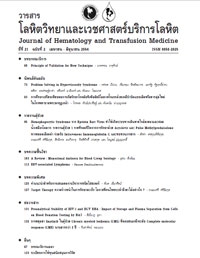Cytochemistry and Multi-color Flow Cytometric Immunophenotype for Diagnosis of Childhood Acute Leukemia
Keywords:
มะเร็งเม็ดเลือดขาวชนิดเฉียบพลัน, cytochemistry, flow cytometry, Acute leukemiaAbstract
บทคัดย่อ
Cytochemistry และ flow cytometry เป็นเทคนิคที่ใช้ในการวินิจฉัยโรคมะเร็งเม็ดเลือดขาวชนิดเฉียบพลันในวัยเด็ก การศึกษานี้เพื่อประเมินประโยชน์ของเทคนิคดังกล่าวในการวินิจฉัยโรคมะเร็งเม็ดเลือดขาวชนิดเฉียบพลันในวัยเด็ก โดยเป็นการศึกษาแบบย้อนหลังในผู้ป่วยรายใหม่จำนวน 114 ราย (ชาย 75 รายและหญิง 39 ราย) ค่ามัธยฐานของอายุ 6 ปี (0-15 ปี) ค่าทางโลหิตวิทยาแสดงภาวะซีด (hemoglobin<10 g/dL) และเกล็ดเลือดต่ำ(น้อยกว่า 100 x109/L) ร้อยละ 71 และ 80 ตามลำดับ โดย ร้อยละ 66 ของผู้ป่วยพบ blast ในกระแสเลือดมากกว่าร้อยละ 25 พบผู้ป่วยเป็น acute myeloid leukemia (AML) 30 ราย (ร้อยละ 26.3) โดยเป็นชนิด FAB M2 มากที่สุด การย้อม myeloperoxidase ให้ผลบวกแรงกับ FAB M1 ถึง M3 ผล flow cytometry พบว่า CD13 และ CD33 ให้ผลบวกกับ AML เกือบทุกราย การแสดง aberrant lymphoid antigen พบมากถึงร้อยละ 47 โดยพบ CD7 มากที่สุด พบ acute lymphoblastic leukemia (ALL) จำนวน 84 ราย (ร้อยละ 73.7) โดยพบชนิด B lineage ร้อยละ 85.7 และ T lineage ร้อยละ 14.3 ชนิดย่อย early pre B ALL (CD10+) พบมากถึง 62 ราย (ร้อยละ 86.1) และพบการแสดง aberrant myeloid antigen ร้อยละ 14 เป็นชนิด CD11b, CD13, CD15 และ CD33 การศึกษานี้แสดงถึงประโยชน์ของการใช้ cytochemistry และ flow cytometry ที่มีต่อการวินิจฉัยที่แม่นยำและสามารถแยกชนิดย่อยมะเร็งเม็ดเลือดขาวชนิดเฉียบพลันในวัยเด็ก
Key Words : มะเร็งเม็ดเลือดขาวชนิดเฉียบพลัน ; cytochemistry ; flow cytometry
Abstract
The combined techniques of cytochemistry and flow cytometry are currently used for definite diagnosis and risk stratification of childhood acute leukemias. The aim of the study was to evaluate the usefulness of these methods for establishing diagnosis of childhood acute leukemias. This was a retrospective study of children with newly diagnosed acute leukemia. One hundred and fourteen children, 75 males and 39 females, with a median age of 6 years (0-15 years) were included in the study. Blood counts showed anemia (Hb <10 g/dL) and thrombocytopenia (platelets <100 x109/L) in 71% and 80%, respectively. Most of the patients (66%) presented with significant blast cells (>25%) in peripheral blood. Acute myeloid leukemia (AML) represented 26.3% (30) of cases. FAB M2 cell type was the most common AML. Myeloperoxidase enzyme reactivity was strong in M1 to M3. CD13 and CD33 were the most useful markers for diagnosis of AML. Aberrant expression of lymphoid antigens was seen in 47%, in which CD7 was the most frequent. Acute lymphoblastic leukemia (ALL) was diagnosed in 84 (73.7%) cases. Flow cytometry detected B lineage in 85.7% and T lineage in 14.3%. The early pre B ALL (CD10+) was found in 62 cases (86.1%). Expression of myeloid antigens including CD11b, CD13, CD15, or CD33 was detected in 14% of B lineage ALL. This study demonstrated that cytochemistry and flow cytometry were successfully used for diagnosis and subtype classification of childhood acute leukemias.
Key Words : Acute leukemia ; Cytochemistry ; Flow cytometry



